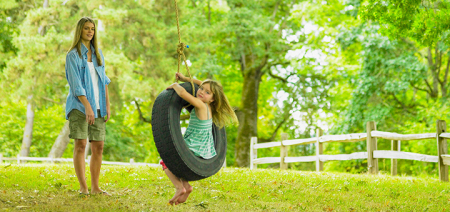'Friendly' Flies Not Friendly To Caterpillars
Published:
June 21st, 2007
By:
Bob McNitt

I find it amusing how false rumors start and spread, and those that you may hear regarding the outdoors are no different. Take, for example, when coyote populations and range (also called brush wolves and coydogs) first started expanding in the state. Rumors were flying that the NYS Conservation Department, at the request of auto insurance companies, was "stocking" them to help control the abundant deer that were creating too many car-deer accidents.
A few decades later, it was mountain lions that were being stocked by the State, again to help control overabundant deer herds. This year, the rumor making the rounds involves all the oversized houseflies that are so numerous. Again, the credit is being attributed to the State, releasing them via helicopters to help control the bumper crop of forest tent caterpillars that are munching the leaves from our area's trees this year.
Basically, what is occurring is a common phenomena in nature - when a certain species' population or habitat grows or peaks cyclically, there can be an almost equal or opposite effect on certain other species. Case in point is the expansion of coyotes into New York. As abandoned farmlands were naturally replaced by thicker, heavier vegetation, the habitat created was more suitable to the wild canids. That same habitat change was responsible for increased deer densities, which offered the coyotes increased prey opportunities via fawns and winter-yarded deer. Conversely, this habitat change negatively affected the once numerous pheasant population. The appearance and continuing increase in black bears in our region is, again, the result of habitat changes favorable to the bruins.
The increased presence of the large flies we're seeing this year is directly tied to the cyclic peak in forest tent caterpillars since these oversized "house flies" – often called "friendly flies" – feed on the caterpillars. More available prey supports more predators. It's as simple as that. Ironically, these flies are also sometimes called "government flies" due to the rumors that the government releases them to feed on the caterpillars, which is undoubtedly the basis for the local stories being spread this year.
Scientifically, these flies are "Sarcophaga aldrichi," and resemble houseflies but are larger, slower and distinctly more bristly. Adult flies are gray in color and are 6 to l2 mm long. The sides of their "faces" are hairy, each end of their two antennae has a single and branched bristle, their thoraxes have three black stripes, and their abdomens are checkered.
When friendly flies occur in large numbers, as they have this year, they can be a nuisance because they drone persistently and often land on people and food. Adults are strong and active fliers and they swarm over everything including people, livestock, pets, lights, light-colored garments and laundry hung out to dry. They don't bite but can soil clothes, laundry and food with their regurgitations. Unlike other flies which can be "shoo'd" away, friendly flies usually must be brushed away.
Between forest tent caterpillar outbreaks, the friendly fly population collapses and they survive in low numbers by depositing their larvae on carrion, dung and various decaying materials. In addition to friendly flies, several other species of flies and wasps parasitize the eggs, larvae and pupae of the forest tent caterpillars, as do beetles, ants, spiders, birds, wood frogs, toads, deer mice, and skunks.
It can be frustrating dealing with the large numbers of friendly flies. Tolerating them until their numbers decline and then disappear for the year, usually in mid to late July, is how best deal with them. However big a nuisance they may be, they are primarily responsible for the decline in the forest tent caterpillar numbers that defoliate our trees. And that's a pretty good trade-off.
Project WILD Honors Laura Carey
New York State DEC has announced that Laura Carey, an environmental educator at DEC's Rogers Environmental Education Center and New York State's Project WILD (Wildlife in Learning Design) coordinator, received the Project WILD Coordinator of the Year Award.
Laura received this honor at this year's Project WILD Annual International Coordinators Conference and Business Meeting in East Madison, New Hampshire. Nominees are considered on the basis of extraordinary efforts in communication, leadership, initiative, and innovation in the advancement of environmental education through Project WILD.
Project WILD is an interdisciplinary conservation and environmental education program emphasizing wildlife for K-12 students. Activities raise student awareness and knowledge about wildlife and the environment, and help develop problem-solving and decision-making skills.
Each year in New York State, more than 2,000 educators are trained in Project WILD where pre-service teachers at twenty colleges and universities across the state, as well as in-service teachers and non-formal educators, learn about the wildlife and natural resources of New York. They also receive materials that will help them form a strong stewardship ethic in their students. Since the program began in 1984, more than 50,000 educators have been trained statewide.
Laura was the regional Project WILD coordinator for central and western New York from 1987 until 2000 and has since then been the statewide coordinator.
Free Fishing This Weekend
June 23 and 24, 2007 are New York's annual free fishing days. During these days anyone can fish in New York State waters without a license. However, current minimum size and daily limits must be adhered to.
Fish And Wildlife Generated $120 Billion Last Year
According to preliminary survey data released today by the U.S. Fish and Wildlife Service, in 2006 more than 87 million Americans, or 38 percent of the United States' population age 16 and older, hunted, fished or observed wildlife. They spent $120 billion that year pursuing those activities -- an amount roughly equal to Americans' total spending at all spectator sports, casinos, motion pictures, golf courses and country clubs, amusement parks and arcades combined.
Author: Bob McNitt - More From This Author
Comments






